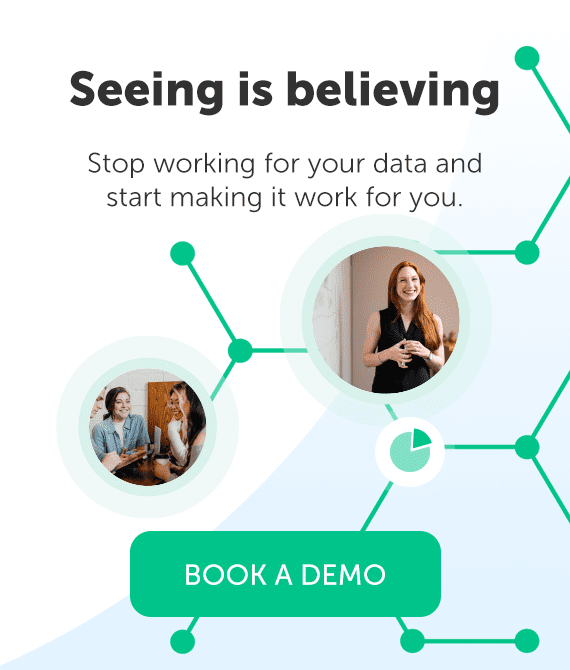Growth has become harder to sustain with the same headcount and the same manual processes. Fee pressure is real, hiring is slow, and client expectations are rising as firms face disruption from M&A, private equity, and shifting market dynamics. Those realities are prompting many leaders to revisit how the work gets done, from how they manage client relationships to how they automate data entry, making digital transformation in accounting a strategic priority. The risk, however, is that firms view accounting technology as the sole solution, without rethinking the workflows that it sits on top of.
How scalable are your processes? And will your teams still be responsible for entering and maintaining the data that those new systems leverage?
These questions sit at the heart of any successful digital transformation strategy in accounting and underscore how important it is to automate data entry early on in the process.
Table of contents
The myth of digital transformation in accounting
Despite the explosion of accounting technology, many firms are still in the early phases of their digital transformation strategy, held back by the legacy processes and manual workflows that have always powered client work and relationship management.
You might have a CRM for accountants, but if your professionals and partners still need to log every client interaction by hand, it isn’t transforming anything. Or your firm might have invested in dashboards or analytics tools, but if the underlying data is incomplete or inconsistent, the insights they produce can’t be trusted.
Just like earlier waves of growth, when talent left the Big Four and brought their expertise to new firms, the profession reshaped itself through expansion and consolidation. More than half of firms from a decade ago no longer exist, replaced by new models and specialties. Today’s transformation will favor those who adapt how they work. Bridging that gap between technology and process is what will ultimately distinguish today’s firms from the accounting firm of the future.
The real bottleneck: your reliance on manual data entry
Every firm wants to modernize, but most underestimate how much manual data entry still holds them back. The problem isn’t just inefficiency; it’s that your entire accounting firm’s digital transformation strategy depends on data that can’t be trusted or easily accessed. The fastest way to break that cycle is to automate data entry so your information updates itself in real-time rather than relying on manual effort.
It drains your professionals’ time
Every hour your partners and managers spend logging notes in a CRM is an hour they aren’t serving clients or building relationships. They know accurate records matter, but entering data doesn’t feel like work that moves the firm forward. When experienced professionals spend time on administrative tasks, you lose both productivity and morale.
Automation changes that equation. When your systems update themselves, your team can focus on higher-value work that actually drives growth and improves client relationships. That shift also changes how firms think about their CRM for accountants, from a static database to a living system that supports business development and client service.
It creates untrustworthy data
Manual data entry always leads to gaps. People forget to log calls, skip updates, or record incomplete details. Over time, your systems become filled with outdated or inaccurate information. When that happens, your data stops being a reliable source of insights that fuel client engagement and pursuits.
It prevents a 360-degree client view
How well can you know a client when the data’s siloed across teams and systems? When contact details, meeting notes, and relationship history sit in different systems, or worse, personal inboxes, it’s almost impossible to see how your firm actually engages with a client.
Automated enrichment of CRM data brings that picture into focus, creating a clear, connected view of how your firm engages with clients: who’s engaging with whom, how strong your relationships are, where accounts are overly reliant on a single contact, and where opportunities exist to deepen client relationships to deliver greater value and drive growth. This kind of visibility empowers better client service and more informed decision making by firm leadership.
The true first step of digital transformation: automating your data foundation
Meaningful change and real efficiency begins by addressing the root cause. When your team is still entering data by hand, every new tool you add just hides the same underlying problem.
Every major system in your firm, from CRM and analytics to practice management and client service tools, depends on clean and connected data. When data entry is manual, even simple questions like who owns a client relationship or who last spoke to them become difficult to answer. Mismatched contact lists create duplicate outreach, missed event invites, and gaps in segmentation, and IT spends its time consolidating systems and data sources instead of supporting business development.
Automation changes that by removing the human bottleneck. The result is a self-maintaining data ecosystem: accurate contact and activity data flows automatically into your CRM and analytics tools, eliminating manual updates and reducing integration headaches across the tech stack, while giving firm leaders the visibility to measure relationship strength, client engagement, and growth opportunities in real-time.
Passive data capture
Introhive’s passive data capture eliminates one of the biggest drains on your professionals’ time: keeping CRM records up to date. It automatically collects contact details, emails, and meetings from the work your firm already does every day. When a meeting is scheduled, a call happens, or a contact is copied on correspondence, that information updates in the background. The CRM reflects what’s actually happening in the firm without anyone needing to type a thing.
This kind of accounting technology doesn’t just save time. It builds trust. When partners can rely on accurate, automatically captured relationship data, they’ll have the insights they need, without ever having to update the CRM themselves.
Automated data enrichment
While capturing activity is the first step, making it usable is the next. Even when firms have data, it’s often incomplete or inconsistent, with multiple versions of a contact, missing company details, or outdated job titles. That’s where automation continues the work.
Accounting technology like Introhive’s enrichment capabilities standardize and enhance the data the firm already owns. It matches contacts to verified sources, fills in missing details like industries and titles, and links related companies and relationships. What you end up with isn’t just a cleaner database; it’s a real map of your firm’s network.
That map lets leadership see which clients are deeply connected and which ones are at risk by being overly dependent on a single contact. It highlights where the firm’s relationships are strongest and where new opportunities might come from. This is the kind of insight that drives decisions about targeting, resourcing, and client service.
What’s possible with a transformed data foundation
With accurate, connected data, your firm can uncover warm introductions, strengthen key accounts, and focus growth efforts where they’ll have the most impact. According to Accounting Today’s analysis of emerging opportunities in the profession, growth is increasingly coming from firms that can identify expansion opportunities earlier – something that’s only possible with reliable relationship and activity data.
Accurate business development analytics
Right now, many firms can’t tell whether growth is coming from new clients, expanded engagements, or a few rainmakers are driving most of the results. Yet according to the latest High Growth Study for accounting and financial services firms, the fastest-growing firms are those that use data to identify where relationships are deepening and opportunities are expanding.
That same principle applies within your own firm. With accurate, automated data, you can trace every engagement back to its source and understand what’s really driving growth. By tracing every engagement over time straight back to its source, you can see which relationships are driving new introductions, where activity is increasing or slowing, and which clients are creating opportunities to expand existing work. That level of visibility is what separates an accounting firm of the future from one still relying on disconnected spreadsheets and is what lets you manage business development with the discipline you bring to financial performance. It’s all about knowing, with confidence, where your firm’s growth actually comes from.
Intelligent cross-selling
Cross-selling has always been a challenge because relationship data lives in silos. The audit team doesn’t see that tax has a strong contact, and advisory doesn’t know a client just expanded into a new region. When data is connected, these untapped networks appear automatically.
For example, Introhive’s relationship mapping and Pathways reveal how contacts and connections span across practices, helping firms uncover new routes to opportunity. If a long-time audit client acquires a company in a new jurisdiction, Pathways can show which colleagues already have relationships in that market, making it easier to coordinate outreach and expand the relationship.
In that way, cross-selling shifts from a yearly initiative to an everyday part of how your teams already work together.
Seamless succession planning
The real test of your data foundation comes when a key partner retires or changes roles. In most firms, client history lives in email archives or personal notes, which means valuable relationship intelligence is at risk of disappearing when people move on. With automated, centralized data, every touchpoint stays visible: from the introductions that opened doors to the meetings and correspondence that strengthened the connection. The firm retains the full relationship context, making transitions smoother and more transparent.
You can even identify the right successor early and monitor whether they’re being brought into client meetings and communications throughout the transition. When that time comes, the new relationship owner steps in with complete context and a clear path to maintain client continuity and trust.
Your digital transformation roadmap starts here
Digital transformation in accounting doesn’t begin with AI, analytics, or another new platform. It begins with the quality of the data that connects them all. Until you automate data entry and maintenance, every new system you buy will depend on manual work to keep it running. Becoming an accounting firm of the future starts with embedding automation into your foundation so your people and technology can grow together.
As the fastest-growing accounting firms continue to invest in automation and data infrastructure, the gap between firms that modernize and those that don’t will only widen.
If you’re ready to see what that looks like in practice, book a demo with Introhive and see how automation and data enrichment technology can set up your accounting firm for real transformation.
Want to go a step further? Explore our interactive demo to see a day in the life of a partner using Introhive, and how better data strengthens client relationships and supports more strategic advice.





